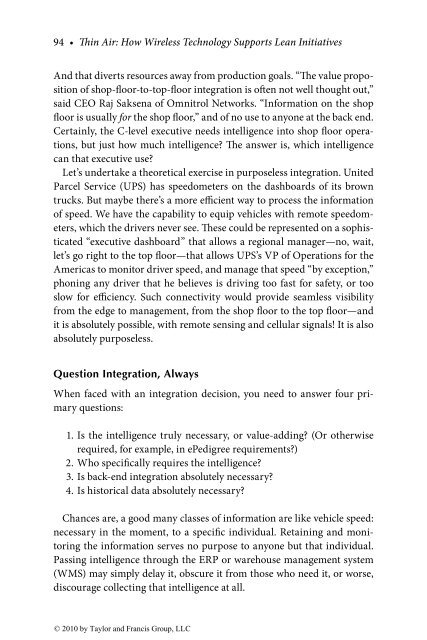Thin Air: How Wireless Technology Supports Lean ... - Prepaid MVNO
Thin Air: How Wireless Technology Supports Lean ... - Prepaid MVNO
Thin Air: How Wireless Technology Supports Lean ... - Prepaid MVNO
Create successful ePaper yourself
Turn your PDF publications into a flip-book with our unique Google optimized e-Paper software.
94 • <strong>Thin</strong> <strong>Air</strong>: <strong>How</strong> <strong>Wireless</strong> <strong>Technology</strong> <strong>Supports</strong> <strong>Lean</strong> Initiatives<br />
And that diverts resources away from production goals. “The value proposition<br />
of shop-floor-to-top-floor integration is often not well thought out,”<br />
said CEO Raj Saksena of Omnitrol Networks. “Information on the shop<br />
floor is usually for the shop floor,” and of no use to anyone at the back end.<br />
Certainly, the C-level executive needs intelligence into shop floor operations,<br />
but just how much intelligence? The answer is, which intelligence<br />
can that executive use?<br />
Let’s undertake a theoretical exercise in purposeless integration. United<br />
Parcel Service (UPS) has speedometers on the dashboards of its brown<br />
trucks. But maybe there’s a more efficient way to process the information<br />
of speed. We have the capability to equip vehicles with remote speedometers,<br />
which the drivers never see. These could be represented on a sophisticated<br />
“executive dashboard” that allows a regional manager—no, wait,<br />
let’s go right to the top floor—that allows UPS’s VP of Operations for the<br />
Americas to monitor driver speed, and manage that speed “by exception,”<br />
phoning any driver that he believes is driving too fast for safety, or too<br />
slow for efficiency. Such connectivity would provide seamless visibility<br />
from the edge to management, from the shop floor to the top floor—and<br />
it is absolutely possible, with remote sensing and cellular signals! It is also<br />
absolutely purposeless.<br />
Question Integration, Always<br />
When faced with an integration decision, you need to answer four primary<br />
questions:<br />
1. Is the intelligence truly necessary, or value-adding? (Or otherwise<br />
required, for example, in ePedigree requirements?)<br />
2. Who specifically requires the intelligence?<br />
3. Is back-end integration absolutely necessary?<br />
4. Is historical data absolutely necessary?<br />
Chances are, a good many classes of information are like vehicle speed:<br />
necessary in the moment, to a specific individual. Retaining and monitoring<br />
the information serves no purpose to anyone but that individual.<br />
Passing intelligence through the ERP or warehouse management system<br />
(WMS) may simply delay it, obscure it from those who need it, or worse,<br />
discourage collecting that intelligence at all.<br />
© 2010 by Taylor and Francis Group, LLC
















